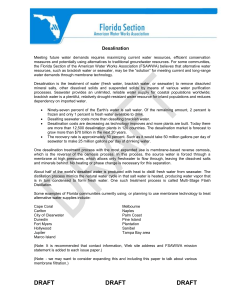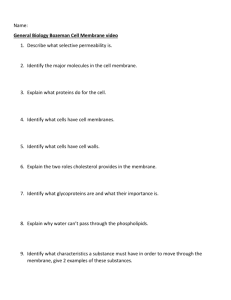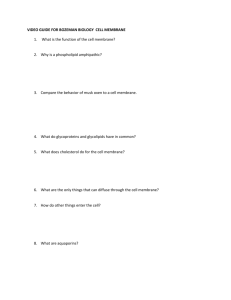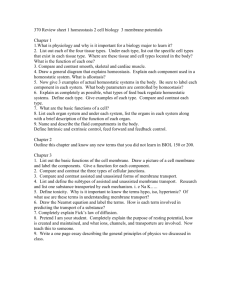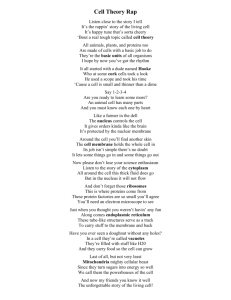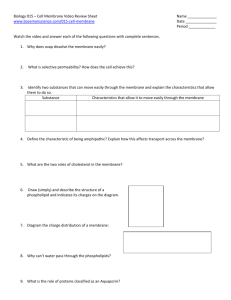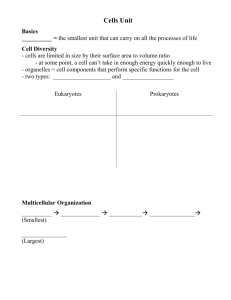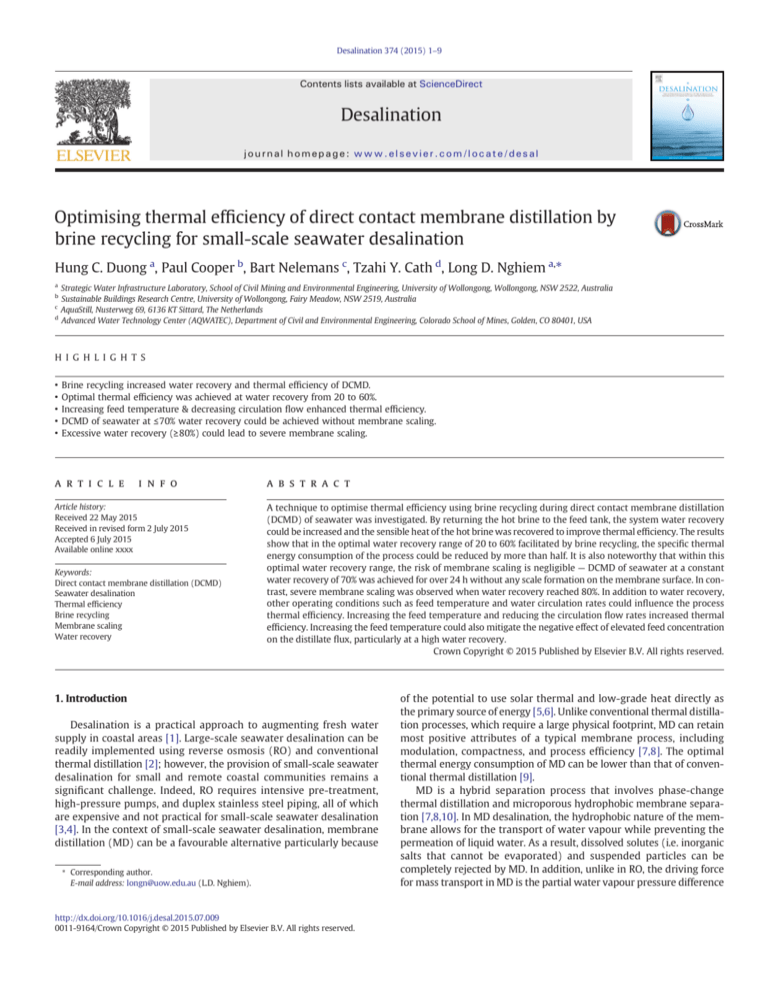
Desalination 374 (2015) 1–9
Contents lists available at ScienceDirect
Desalination
journal homepage: www.elsevier.com/locate/desal
Optimising thermal efficiency of direct contact membrane distillation by
brine recycling for small-scale seawater desalination
Hung C. Duong a, Paul Cooper b, Bart Nelemans c, Tzahi Y. Cath d, Long D. Nghiem a,⁎
a
Strategic Water Infrastructure Laboratory, School of Civil Mining and Environmental Engineering, University of Wollongong, Wollongong, NSW 2522, Australia
Sustainable Buildings Research Centre, University of Wollongong, Fairy Meadow, NSW 2519, Australia
AquaStill, Nusterweg 69, 6136 KT Sittard, The Netherlands
d
Advanced Water Technology Center (AQWATEC), Department of Civil and Environmental Engineering, Colorado School of Mines, Golden, CO 80401, USA
b
c
H I G H L I G H T S
•
•
•
•
•
Brine recycling increased water recovery and thermal efficiency of DCMD.
Optimal thermal efficiency was achieved at water recovery from 20 to 60%.
Increasing feed temperature & decreasing circulation flow enhanced thermal efficiency.
DCMD of seawater at ≤70% water recovery could be achieved without membrane scaling.
Excessive water recovery (≥80%) could lead to severe membrane scaling.
a r t i c l e
i n f o
Article history:
Received 22 May 2015
Received in revised form 2 July 2015
Accepted 6 July 2015
Available online xxxx
Keywords:
Direct contact membrane distillation (DCMD)
Seawater desalination
Thermal efficiency
Brine recycling
Membrane scaling
Water recovery
a b s t r a c t
A technique to optimise thermal efficiency using brine recycling during direct contact membrane distillation
(DCMD) of seawater was investigated. By returning the hot brine to the feed tank, the system water recovery
could be increased and the sensible heat of the hot brine was recovered to improve thermal efficiency. The results
show that in the optimal water recovery range of 20 to 60% facilitated by brine recycling, the specific thermal
energy consumption of the process could be reduced by more than half. It is also noteworthy that within this
optimal water recovery range, the risk of membrane scaling is negligible — DCMD of seawater at a constant
water recovery of 70% was achieved for over 24 h without any scale formation on the membrane surface. In contrast, severe membrane scaling was observed when water recovery reached 80%. In addition to water recovery,
other operating conditions such as feed temperature and water circulation rates could influence the process
thermal efficiency. Increasing the feed temperature and reducing the circulation flow rates increased thermal
efficiency. Increasing the feed temperature could also mitigate the negative effect of elevated feed concentration
on the distillate flux, particularly at a high water recovery.
Crown Copyright © 2015 Published by Elsevier B.V. All rights reserved.
1. Introduction
Desalination is a practical approach to augmenting fresh water
supply in coastal areas [1]. Large-scale seawater desalination can be
readily implemented using reverse osmosis (RO) and conventional
thermal distillation [2]; however, the provision of small-scale seawater
desalination for small and remote coastal communities remains a
significant challenge. Indeed, RO requires intensive pre-treatment,
high-pressure pumps, and duplex stainless steel piping, all of which
are expensive and not practical for small-scale seawater desalination
[3,4]. In the context of small-scale seawater desalination, membrane
distillation (MD) can be a favourable alternative particularly because
⁎ Corresponding author.
E-mail address: longn@uow.edu.au (L.D. Nghiem).
http://dx.doi.org/10.1016/j.desal.2015.07.009
0011-9164/Crown Copyright © 2015 Published by Elsevier B.V. All rights reserved.
of the potential to use solar thermal and low-grade heat directly as
the primary source of energy [5,6]. Unlike conventional thermal distillation processes, which require a large physical footprint, MD can retain
most positive attributes of a typical membrane process, including
modulation, compactness, and process efficiency [7,8]. The optimal
thermal energy consumption of MD can be lower than that of conventional thermal distillation [9].
MD is a hybrid separation process that involves phase-change
thermal distillation and microporous hydrophobic membrane separation [7,8,10]. In MD desalination, the hydrophobic nature of the membrane allows for the transport of water vapour while preventing the
permeation of liquid water. As a result, dissolved solutes (i.e. inorganic
salts that cannot be evaporated) and suspended particles can be
completely rejected by MD. In addition, unlike in RO, the driving force
for mass transport in MD is the partial water vapour pressure difference
2
H.C. Duong et al. / Desalination 374 (2015) 1–9
across the membrane, which is mainly induced by a transmembrane
temperature difference. Thus, water flux in MD is negligibly affected
by the feed water salinity. In other words, MD can be used for desalinating hypersaline feed streams or to achieve high water recovery desalination [11–16]. Given the discontinuity of the liquid phase across the
membrane and a small hydraulic pressure on the membrane surface,
MD is less susceptible to membrane fouling compared to RO, and
hence does not require extensive pre-treatment [7]. More importantly,
due to the absence of high hydraulic pressure, which is required for
RO, non-corrosive and inexpensive plastic materials can be used for
MD infrastructure (i.e. membrane modules, vessels, and piping), thus
significantly reducing capital costs. Furthermore, by using a microporous membrane to facilitate the transport of water vapour, MD is more
compact and thus has a significantly smaller footprint compared to
conventional thermal distillation. Finally, MD is often operated at feed
temperature ranging from 40 to 80 °C, which coincides with the optimal
range of most thermal solar collectors [17]. Given these attributes, MD is
arguably the most promising candidate for portable, stand-alone, and
solar driven seawater desalination applications [17–19].
In practice, the use of MD for seawater desalination is still largely restricted to pilot-scale demonstrations [7]. Technical challenges, namely
intensive energy consumption and membrane pore wetting, must be
overcome before seawater desalination by MD can be commercially
realised. As a phase-change separation process, MD consumes significant heating and cooling energy to perform the phase conversion. Consequently, all MD processes reported in the literature demonstrate an
energy consumption of several orders of magnitude higher than that
of RO [18,20,21]. In addition, to sustain its separation functionality,
MD requires the membrane pores to be dry. In seawater applications,
organic matter and scale formed on the membrane surface can alter
the membrane hydrophobicity, which may lead to liquid intrusion
into the pores, and, subsequently, water flux reduction and deteriorated
distillate quality [22–24].
Depending on the methods applied to generate its driving force, MD
can be divided into four basic configurations, including vacuum, air gap,
sweeping gas, and direct contact membrane distillation. Among these
configurations, direct contact membrane distillation (DCMD) has the
simplest arrangement [7], and is deemed best suited for small-scale
desalination applications [7,8]. DCMD has also been the most studied
configuration in the MD literature [7]. However, heat loss due to
conduction through the membrane in DCMD can be significant because
of its simple arrangement (i.e. the hot feed and the cold distillate are
both in contact with the membrane). Thus, DCMD may have a lower
thermal efficiency (i.e. higher thermal energy consumption per unit
volume of distillate) compared to other MD configurations.
Several attempts have been made to reduce energy consumption
and thus enhance thermal efficiency of DCMD desalination processes.
As a notable example, Lin et al. [25] investigated the coupling of
DCMD with an external heat exchanger to recover the latent heat
accumulated in the distillate stream, thus enhancing process thermal
efficiency. The authors demonstrated that if infinite membrane and
heat-exchanging surface area was available, a minimum specific heat
consumption of DCMD (i.e. with a heat exchanger) of 0.03 MJ/L could
be achieved by optimising the ratio between the feed and distillate
flow rates. However, it is impractical to have an infinite membrane
and heat-exchanging surface; thus, in practice, brine recycling can be
used to improve water recovery and thermal efficiency [25]. Brine
recycling for water recovery and thermal efficiency enhancement has
also been suggested by Saffarini et al. [26]. Brine recycling enhances
the utilisation of the available membrane surface area. In other words,
brine recycling can be used to optimise the thermal efficiency without
the need of increasing membrane surface area (or module size). The
cost of membranes is significant [27] and this attribute is particularly
important for small-scale desalination applications. It is noteworthy
that no previous studies have experimentally evaluated brine recycling
in DCMD of seawater.
A major challenge for brine recycling during DCMD of seawater is to
manage the negative effects of increased feed salinity associated with
high water recovery on water flux, distillate quality, and membrane
scaling. This study aims to elucidate the relationship between thermal
efficiency, water recovery, and membrane scaling in DCMD of seawater
with brine recycling. The effects of operating conditions, including
water recovery, feed temperature, and water circulation rates, on
thermal efficiency of the process were systematically examined. The
risk of membrane scaling at a high water recovery from actual seawater
was also investigated.
2. Materials and methods
2.1. DCMD test unit
A flow diagram of the DCMD unit used in this study is shown in Fig. 1.
The membrane cell, provided by Aquastill (Sittard, The Netherlands),
was composed of two polypropylene (PP) semi-cells. Each semi-cell
had a flow channel with depth, width, and length of 0.2, 10, and
50 cm, respectively, forming an active membrane area of 500 cm2. A
flat-sheet, low-density polyethylene (LDPE) membrane (also provided
by AquaStill) having nominal pore size of 0.3 μm, thickness of 76 μm,
and porosity of 85% was installed between the two semi-cells to form
the feed and distillate channels. PP spacers were used in both channels
for improved flow turbulence. Two variable-speed gear pumps (Model
120/IEC71-B14, Micropump Inc., Vancouver, Washington, USA) were
used to circulate the feed and distillate through the membrane cell.
Two rotameters, positioned before the inlet of each channel, were
used to monitor the circulation flow rates of the feed and distillate.
Feed water from a storage tank flowed into the MD feed tank by
gravity via a float valve. The MD feed tank was heated using a submerged heating element connected to a temperature control unit. A
temperature sensor positioned immediately before the inlet of the
feed channel was used to regulate the feed water temperature. Another
temperature sensor was installed at the outlet of the feed channel to
monitor the feed temperature drop along the channel. A peristaltic
pump (Masterflex, John Morris Scientific Pty Ltd., Australia) was used
to bleed the concentrated brine from the MD feed tank when necessary
(see Section 2.3). A chiller (SC200-PC, Aqua Cooler, Sydney, New South
Wales, Australia) was used to control the distillate temperature through
a stainless steel heat-exchange coil submerged directly into the
distillate tank. The temperatures of the distillate entering and leaving
the cell were monitored by two other temperature sensors. A digital balance (PB32002-S, Mettler Toledo, Inc., Hightstown, New Jersey, USA)
connected to a computer was used to weigh the excess distillate flow
for determining the water flux.
2.2. Analytical methods
Electrical conductivity of the feed and distillate was measured using
Orion 4-Star Plus meters (Thermo Scientific, Waltham, Massachusetts,
USA). Contact angle of the membrane surface before and after experiments was measured by the sessile drop technique using a Rame-Hart
Goniometer (Model 250, Rame-Hart, Netcong, New Jersey, USA). Milli-Q
water was used as the reference liquid for the contact angle measurements. Morphology and composition of the membrane surface were examined using a low vacuum scanning electron microscope (SEM)
coupled with an energy dispersive spectrometer (EDS) (JOEL JSM6490LV, Japan). The membrane samples were air-dried and then directly used (i.e. without coating) for SEM-EDS analysis.
2.3. Experimental protocols
2.3.1. Feed solutions
Milli-Q water, synthetic 35,000 mg/L NaCl solution, and pre-filtered
seawater were used as feed solutions. Seawater was collected from
H.C. Duong et al. / Desalination 374 (2015) 1–9
3
Fig. 1. Schematic diagram of the DCMD system used in the study.
Wollongong beach (New South Wales, Australia) and was pre-filtered
by 0.5 μm filter paper prior to all experiments. The conductivity, pH,
and total dissolved solids of this pre-filtered seawater were 52.5 ± 1.0
mS/cm, 8.35 ± 0.05, and 37,000 ± 2000 mg/L, respectively. The total organic carbon (TOC) concentration of this pre-filtered seawater was less
than 2 mg/L. The synthetic NaCl solution was prepared from analytical
grade chemical and Milli-Q water.
2.3.2. DCMD of Milli-Q water and saline solutions
DCMD of Milli-Q water was conducted to determine the system's
baseline mass transfer coefficient prior to the experiments with the saline solutions. The process was operated at constant water circulation
rates (1.25 L/min) and distillate temperature (25 °C), but varied feed
temperature (i.e. 35, 40, 45, 50 °C). Water flux of the DCMD was measured at each feed temperature at stable conditions for three hours.
Concentrating and constant recovery operating modes were used in
the DCMD experiments with saline solutions. In the concentrating
mode, the volume of feed solution in the feed tank was allowed to
decrease, thus resulting in an increase in feed salinity over time. The
water recovery (Rec) of the system in this mode was the ratio between
the accumulated distillate volume and the initial feed volume. In the
constant recovery mode, concentrated brine was bled out and saline
solution was allowed to flow into the MD feed tank via the float valve
(Fig. 1). The bled-out flow rate is calculated as:
F brineout ¼ F d
!
"
1
−1
Rec
ð1Þ
where Fbrineout and Fd are the volumetric flow rates (m3/s) of bled-out
brine and produced distillate, respectively, and Rec is the predetermined
system water recovery. In the constant recovery mode, Rec is defined as:
Rec ¼
Fd
F sys
ð2Þ
where Fsys is the volumetric flow rate of saline water fed into the MD
feed tank. In both concentrating and constant recovery modes, a
concentration factor (CF) can be determined:
CF ¼
1
:
1−Rec
ð3Þ
Prior to constant recovery operation, the feed was first concentrated
to reach a predetermined water recovery. Then, the constant recovery
mode was initiated and maintained for at least 24 h before being terminated or switched to another water recovery set point. At the end of the
experiments with the pre-filtered seawater, the membrane sample was
removed for subsequent contact angle measurement and SEM-EDS
analysis. To ensure experimental reproducibility, a new membrane
sample and 2 L of Milli-Q water as the initial distillate were used for
each experiment.
2.4. Mass transfer of water in DCMD
The mass transfer of water vapour across the membrane in DCMD
depends on the membrane properties and operating conditions, and
can be expressed as:
J ¼ K m ΔP
ð4Þ
where J is the water flux of the system (L/m2·h); Km is the mass transfer
coefficient (L/Pa·m2·h); ΔP is the water vapour pressure difference
between the vapour–liquid interfaces formed at two sides of the membrane (Pa). The mass transfer coefficient is a function of membrane
properties and operating conditions, including feed and distillate temperatures, pressures, and water circulation rates. Km can be determined
using empirical correlations [7,28] or experimentally measured [22].
The vapour pressure of pure water at the membrane surface can be
calculated using the Antoine equation:
!
"
3816:44
P 0 ¼ exp 23:1964−
T−46:13
ð5Þ
where P0 is in Pa and T is the temperature in K. For a saline solution, the
presence of salts in the solution reduces water activity and, hence, water
vapour pressure. Thus, the partial vapour pressure of water at the membrane surfaces in DCMD of saline solutions (P) is calculated as [29]:
#
$
P ¼ xwater 1−0:5xsalt −10x2salt P 0
ð6Þ
where x water and x salt are the molar fraction of water and salts,
respectively.
For DCMD of a diluted solution, xsalt is negligible and thus the
concentration polarisation effect can be ignored. On the other hand,
due to temperature polarisation, the real transmembrane temperature
difference is smaller than that between the bulk feed and distillate
(which can be readily measured), thus reducing the driving force
for mass transfer. However, the effect of temperature polarisation can
be incorporated into the mass transfer coefficient, Km, and ΔP can be calculated using the average temperatures of the bulk feed and distillate
(i.e. {Tf.in + Tf.out}/2 and {Td.in + Td.out}/2, respectively).
4
H.C. Duong et al. / Desalination 374 (2015) 1–9
2.5. Energy consumption and thermal efficiency in DCMD
3. Results and discussions
In MD, thermal energy is required to heat the saline feed solution
and to cool the distillate. In this study, a chiller was used as a heat
sink. However, in practice, seawater at ambient temperature can be circulated through a heat-exchanging coil for cooling. Thus, cooling energy
was excluded when calculating the process thermal efficiency.
The efficiency of a thermal desalination process can be determined
by the specific thermal energy consumption (STEC), which is the thermal energy consumed per unit volume of distillate produced [18,30].
Based on a heat and mass balance (Fig. 2), the STEC (in MJ/L) of DCMD
without brine recycling can be calculated as:
3.1. Water flux and mass transfer coefficient in DCMD of diluted solution
STEC ¼
#
$
ρ f :in F f :in C P T f :in −T sys
ð7Þ
F d $ 106
where Ff.in, Tf.in, and ρf.in are the inlet volumetric flow rate (m3/s), inlet
temperature (°C), and inlet density (kg/m3) of the feed, respectively,
Tsys is the temperature of the saline water in the storage tank (i.e.
assumed to be constant at 25 °C), and CP is the specific heat capacity
of solutions (kJ/kg·°C). When the brine is returned to the feed tank
and the system water recovery remains constant at Rec, the heat input
into the system is:
Q input ¼
#
$
%
&#
$
F d ρsys C P T f :in −T sys
þ C p F f :in ρ f :in −F d ρd T f :in −T f :out
Rec
ð8Þ
where Qinput is in kJ/s, ρsys and ρd are densities of saline water in the storage tank and the distillate (kg/m3), and Tf.out is the outlet temperature of
the feed. Thus, the heat input to the system could be calculated by
measuring the volumetric flow rates of feed and distillate, along with
feed inlet and outlet temperatures. Then, STEC of the process in constant
recovery mode can be calculated as:
STEC ¼
Q input
F d $ 106
:
ð9Þ
Another useful parameter, particularly when involving heat recovery, is the gained output ratio (GOR). GOR is the ratio between the
heat associated with water vapour transfer and the total heat input,
and is calculated as:
GOR ¼
F d ρd ΔH
Q input
ð10Þ
where ΔH is the latent heat of evaporation of water (kJ/kg). The density,
specific heat capacity, and the latent heat of evaporation of saline solutions are dependent on temperature and salinity, and their calculations
are given elsewhere [31]. Unless otherwise stated, for comparison purpose, the STEC and GOR of DCMD reported in this study were calculated
for the constant recovery mode.
As expected, water flux increased as the transmembrane temperature
difference increased (Fig. 3A). When Milli-Q water was used as the feed,
concentration polarisation can be ignored and the mass transfer coefficient of the system, Km, could be obtained (i.e. 1.01 × 10−3 L/Pa·m2·h)
based on Eqs. (4) through (6) and a linear regression between the
water flux and the calculated ΔP. The linear regression coefficient
(R2 value) was 0.999.
3.2. Water flux and thermal efficiency in DCMD of saline solution with brine
recycling
The obtained Km value (Section 3.1) is valid for DCMD of a diluted feed
with negligible concentration polarisation. It is also useful to evaluate the
impact of water recovery on water flux in DCMD of saline solutions with
brine recycling. For the NaCl feed solution of 35,000 mg/L, as water recovery increases, the remaining feed becomes more concentrated because
MD can offer complete salt rejection. However, the increase in water
recovery up to about 40% (i.e. in DCMD at feed temperature of 40 °C)
did not exert any discernible impact on water flux. The measured water
flux coincided with the calculated values using the obtained Km
(Fig. 4A). As water recovery further increased, the increase in salt concentration for each unit increase in water recovery becomes more significant.
As a result, the impact of recovery increase on water flux was noticeable
at water recoveries above 40% (Fig. 4A). As discussed in Section 3.1, the
Km value obtained did not take into account concentration polarisation,
which was significant at high salt concentration in the feed. Thus, the
measured water flux deviated considerably from the calculated values,
especially at high water recoveries. In addition, because the polarisation
effects are magnified by elevating feed temperature, and hence increasing water flux [15,32], the deviation of the measured flux from the calculated values occurred at lower water recovery in the experiments
conducted at higher feed temperatures (Fig. 4A).
Operating DCMD at elevated feed temperatures helped alleviate the
negative effects of feed salinity on water flux at high water recoveries.
At water recoveries below 40%, the normalised water fluxes at the
three feed temperatures were almost identical and were approximately
unity (Fig. 4B), demonstrating the independence of MD flux from feed
salinity at low feed concentrations. As water recovery reached 80%,
water flux declined by 20% at a feed temperature of 50 °C, but it decreased by 50% when operating at a feed temperature of 40 °C. This
could be attributed to the increasing ratio between the driving force,
which depends exponentially on feed temperature, and the feed salinity
as feed temperature rises. The reported result is consistent with previous studies by Duong et al. [30] and Winter et al. [1], emphasising the
significant influence of feed salinity on the performance characteristics
of the MD processes with a small driving force.
Fig. 2. Heat and mass flow in DCMD with brine recycling.
5
10
(A)
10
8
o
o
Tf.in = 55 C
2
o
Tf.in = 50 C
0
10
100
200
300
400
Operating time (mins)
500
600
7
2
4
Tf.in = 40 C
8
Water flux (L/m .h)
Tf.in = 35 C
6
5
4
2
0
-3
J = 1.01x10 ∆P
Measured flux:
o
Tf.in = 50 C
o
o
Tf.in = 45 C
1
(B)
8
Calculated flux:
o
Tf.in = 50 C
3
2
Water flux (L/m .h)
o
6
0
(A)
9
2
Water flux (L/m .h)
H.C. Duong et al. / Desalination 374 (2015) 1–9
Tf.in= 45 C
o
o
Tf.in= 40 C
0
10
Tf.in = 40 C
20
30
40
50
60
70
80
Water recovery (%)
6
Normalised water flux (J/J0)
2
0
(B)
1.0
4
0.8
0
2000
4000
6000
8000
10000
Calculated water vapour pressure difference, ∆ P (Pa)
Fig. 3. (A) Experimentally measured water flux at different feed temperatures and
(B) water flux as a function of the calculated water vapour pressure difference between
the two sides of the membrane in DCMD with Milli-Q water feed. Operating parameters:
Td.in = 25 °C, Ff.in = Fd.in = 1.25 L/min.
Brine recycling in DCMD could be optimised to increase thermal efficiency (Fig. 5). Increasing water recovery by returning the hot brine to
the feed tank resulted in a slight decline in water flux, but a noticeable
improvement in GOR. A significant reduction in STEC was also obtained
by brine recycling. Without brine recycling, the STEC value (i.e. calculated using Eq. (7)) was 16.2 MJ/L. When operating the lab-scale process at
the constant recovery mode with brine recycling to obtain the optimal
water recovery of 30%, a substantial reduction in STEC, to 6.5 MJ/L,
could be achieved. It is noteworthy that this calculated STEC was from
a simple lab-scale DCMD process without any energy recovery. A
lower STEC value (i.e. 1.6 − 2.2 MJ/L) can be obtained from pilot-scale
DCMD processes with energy recovery and better insulation [33,34].
However, the inclusion of an external energy recovery system was not
suitable for a small-scale system and was beyond the scope of our study.
The optimal water recovery for maximised thermal efficiency is
approximately 30%; however, it is noteworthy that changes in both
GOR and STEC values within the water recovery range of 20 to 60% are
negligible (Fig. 5). Thus, 20 to 60% can be taken as the optimal water
recovery range in DCMD desalination with brine recycling. Exceeding
this optimum range, an increase in water recovery led to a small rise
in STEC and a slight decrease in GOR. The decrease in thermal efficiency
at water recoveries above 60% can be attributed to the increased effect
of feed salinity on water flux at high water recoveries. As water recovery
increased, while the required heat input did not change greatly, water
flux of the system gradually decreased. Thus, thermal efficiency of the
system declined as water recovery exceeded the optimum range.
In addition to water recovery, the feed temperature and water
circulation rates had a considerable influence on the thermal efficiency
of the DCMD process. Increasing feed temperature was beneficial for
improving GOR and reducing STEC of the system (Fig. 6A). At low
water recoveries, the influence of feed temperature on GOR and STEC
was not noticeable. However, at high water recoveries, elevating feed
temperature from 45 to 50 °C resulted in a 30% increase in GOR and a
reduction of the same magnitude in STEC. The observed increase in
thermal efficiency at high water recoveries could be attributed to
the mitigated effects of feed salinity at elevated feed temperature as
0.6
o
Tf.in = 50 C
0.4
o
Tf.in = 45 C
o
Tf.in = 40 C
0.2
0.0
0
10
20
30
40
50
60
70
80
Water recovery (%)
Fig. 4. Influence of feed salinity on water flux as water recovery increased in DCMD of the
NaCl 35,000 mg/L solution with brine recycling at different feed temperatures:
(A) calculated and experimentally measured water flux as a function of water recovery,
and (B) normalised measured water flux as a function of water recovery. Operating conditions: Td.in = 25 °C, Ff.in = Fd.in = 1.25 L/min.
discussed above. Reducing water circulation rates also helped increase
thermal efficiency of the system. Operating the system at decreased
circulation rates favoured the reduction in STEC and an improvement
in GOR (Fig. 6B). This observation is consistent with previous results
by Summers et al. [35] and Guan et al. [36] who simulated thermal efficiency of DCMD using a heat-exchanger. It is worth noting that elevating
feed temperature and reducing water circulation rates promote concentration polarisation [15,30,37], and thus might increase the risk of membrane scaling in DCMD of actual seawater.
3.3. Membrane scaling in DCMD with seawater
The performance of DCMD with the pre-filtered seawater operated
in the concentrating mode was similar to that observed in the experiment with the NaCl feed solution (Fig. 7). At water recoveries below
70% (i.e. concentration factor, CF, below 3.3), membrane scaling caused
by the presence of sparingly soluble salts did not occur, indicated by the
steady decrease in the distillate conductivity, even with increased feed
concentration. Thus, there were only effects of temperature and concentration polarisations, and increased feed salinity on water flux, which
were also encountered in DCMD of an NaCl solution. As a result, water
flux gradually decreased when the system water recovery increased to
70%. As the system water recovery approached higher values, water
flux further decreased. However, no significant reduction in water flux
was observed even when the distillate conductivity started increasing,
which is an indication of scale formation and membrane pore wetting.
6
H.C. Duong et al. / Desalination 374 (2015) 1–9
Water flux
STEC
GOR
17
10
0.5
16
15
8
0.4
6
12
11
4
10
0.3
GOR
STEC (MJ/L)
13
2
Water flux (L/m .h)
14
0.2
9
2
0.1
8
7
0
0
10
20
30
40
50
60
70
80
6
90
0.0
Water recovery (%)
Fig. 5. Water flux, STEC, and GOR as a function of water recovery in DCMD of the 35,000 mg/L NaCl solution with brine recycling. Operating parameters: Tf.in = 50 °C, Td.in = 25 °C, Ff.in =
Fd.in = 1.25 L/min.
(A)
16
0.40
0.35
0.30
12
STEC:
o
Tf.in = 50 C
10
GOR:
0.25
o
Tf.in = 50 C
o
o
Tf.in = 45 C
Tf.in = 45 C
8
0.20
6
0.15
0
10
20
30
GOR
STEC (MJ/L)
14
40
50
Water recovery (%)
60
70
80
0.45
7.2
7.0
0.40
6.8
0.35
6.6
0.30
GOR
STEC
6.4
0.25
0.20
6.2
6.0
GOR
STEC (MJ/L)
(B)
0.75
1.00
1.25
0.15
Water circulation rates (L/min)
Fig. 6. Influence of operating conditions on thermal efficiency of DCMD with brine recycling. (A) STEC and GOR as a function of water recovery at feed temperature, Tf.in, of 45 and 50 °C;
other operating conditions: Td.in = 25 °C, Ff.in = Fd.in = 1.25 L/min. (B) STEC and GOR at water circulation rates of 0.75, 1.00, and 1.25 L/min, and water recovery of 60%; other operating
conditions: Tf.in = 50 °C, Td.in = 25 °C.
7
H.C. Duong et al. / Desalination 374 (2015) 1–9
Water flux
Feed EC
Distillate EC
10
10
180
160
8
6
100
80
4
60
40
2
Feed EC (mS/cm)
120
2
Water flux (L/m .h)
140
6
4
Distillate EC (µS/cm)
8
2
20
0
0
10
20
30
40
50
60
70
80
0
0
Water recovery (%)
Fig. 7. Water flux, feed and distillate electrical conductivity (EC) as a function of water recovery in DCMD of pre-filtered seawater. Operating conditions: Tf.in = 50 °C, Td.in = 25 °C, Ff.in =
Fd.in = 1.25 L/min.
Surface analysis of the membrane after the experiment with prefiltered seawater confirmed the deposition of scale on the membrane
surface. Indeed, contact angle of the scaled membrane decreased to
20° while that of the virgin membrane was 116°. SEM imaging (Fig. 8)
reveals a thick and porous layer of salt crystals on the membrane surface
at the completion of the experiment. It is possible that the salt crystals
did not completely clog the membrane pores, and thus did not result
in a significant decrease in water flux. Nevertheless, they drastically
altered the hydrophobicity of the membrane surface layer. Qualitative
elemental analysis of the scale layer using EDS shows that its main compositions were carbonate and sulphate salts of calcium and magnesium.
Morphology of these crystals (Fig. 8) is consistent with calcium sulphate
precipitate [38].
3.4. DCMD of seawater with brine recycling at high water recoveries
DCMD of pre-filtered seawater with brine recycling at constant
water recoveries of 60 and 70% (CF of 2.5 and 3.3, respectively) could
be achieved without any observable membrane scaling. In the concentrating mode, the increase in water recovery resulted in a gradual rise
in feed salinity (represented by the feed conductivity) and hence, a
steady decrease in water flux (Fig. 9). When the process was operated
in the constant recovery mode at 60 and 70% for over 24 h at each
water recovery, both stable feed salinity and a constant water flux
were achieved. The conductivity of the distillate steadily decreased
during the first 25 h of operation before stabilising around 2 μS/cm for
the remainder of the test. The observed decrease in the distillate conductivity was because of the dilution of the Milli-Q water (conductivity
of 8.5 μS/cm) which was initially used as the condensing liquid. The
constant water flux, obtained along with superior distillate quality, indicates that membrane scaling did not occur throughout the operation.
The analysis of membrane surface at the completion of the operation
also supports the absence of membrane scaling. Contact angle of the
membrane decreased slightly to 100°. No evidence of scaling could be
seen from the SEM image of the membrane after DCMD experiment at
70% water recovery (Fig. 10). Traces of sodium, chloride and silica
could be observed from the EDS spectra; however, the intensity of
these peaks is negligible (Fig. 10A) compared to the EDS spectra of the
virgin membrane (Fig. 10B).
There appears to be a trade-off between increasing water recovery
and improving performance of the system in DCMD of seawater at
high water recoveries. By increasing water recovery from 60 to 70%,
the volume of the discharged MD brine can be reduced by 25%. However,
this increase in water recovery also resulted in a small reduction in water
Fig. 8. SEM images and EDS spectra of the membrane after the concentrating DCMD of pre-filtered seawater up to 80% water recovery.
8
H.C. Duong et al. / Desalination 374 (2015) 1–9
Water flux
10
Feed EC
Distillate EC
160
12
140
100
(B)
60%
4
(C)
60
-70%
(D)
70%
80
60
(A)
2 0-60%
6
4
40
20
0
8
10
20
30
40
50
0
60
Distillate EC (µS/cm)
120
6
0
10
Feed EC (mS/cm)
2
Water flux (L/m h)
8
2
0
Operating time (hours)
Fig. 9. Water flux, feed and distillate electrical conductivity as a function of operating time in DCMD of pre-filtered seawater with brine recycling at different operation modes:
(A) concentrating operation with increased water recovery from 0 to 60%, (B) operation at constant water recovery of 60%, (C) concentrating operation with increased water recovery
from 60 to 70%, and (D) operation at constant water recovery of 70%. Operating conditions: Tf.in = 50 °C, Td.in = 25 °C, Ff.in = Fd.in = 1.25 L/min.
flux (i.e. from 8 to 7 L/m2·h), and a slight decrease in the GOR value from
0.35 to 0.33 (corresponding to an increase in the STEC value from 6.8 to
7.1 MJ/L). Moreover, excessive water recovery can lead to the formation
of scale on the membrane surface as discussed above.
Thermal efficiency of seawater DCMD with brine recycling when operating at the constant water recovery of 60% was more than doubled
compared to that of a single-pass process (i.e. STEC decreased from
16.2 to 6.8 MJ/L, and GOR increased from 0.15 to 0.35). Nevertheless,
the thermal efficiency of the DCMD test unit was still lower compared
to those reported in the MD literature [18,30]. It is important to note
that the recovery of latent heat from the distillate stream back to the
feed stream by using a heat exchanger was not implemented in this
study. The thermal efficiency of the DCMD process coupled with a
heat exchanger can be improved significantly [25,33,36], but will also
increase the system complexity, rendering it unsuitable for small-scale
operation.
(A)
(B)
Fig. 10. SEM images and EDS spectra of (A) the membrane after DCMD of pre-filtered seawater at 70% water recovery, and (B) the virgin membrane.
H.C. Duong et al. / Desalination 374 (2015) 1–9
4. Conclusions
A reduction of over 50% in the specific thermal energy consumption
of DCMD of seawater could be achieved by brine recycling. The experimental results reveal an optimal water recovery range of 20 to 60% with
respect to thermal efficiency. A high water recovery beyond this optimal
range led to an increase in the risk of membrane scaling. Indeed, severe
membrane scaling was observed at 80% water recovery. On the other
hand, DCMD of seawater at water recovery of up to 70% was operated
for over 24 h without any observable membrane scaling. Results reported
here suggest that the risk of membrane scaling within the water recovery
range for an optimal thermal efficiency is negligible. In addition to water
recovery, feed temperature and water circulation rates could also influence the process thermal efficiency. Elevating feed temperature and reducing circulation rates increased thermal efficiency. Increasing feed
temperature also helped reduce the negative effect of increased feed salinity on water flux at a high water recovery.
Acknowledgements
Technical assistance of Mitchell Nancarrow and Tony Romeo from
the Electron Microscopy Centre (University of Wollongong) is gratefully
acknowledged.
References
[1] D. Winter, J. Koschikowski, M. Wieghaus, Desalination using membrane distillation:
experimental studies on full scale spiral wound modules, J. Membr. Sci. 375 (2011)
104–112.
[2] M. Elimelech, W.A. Phillip, The future of seawater desalination: energy, technology,
and the environment, Science 333 (2011) 712–717.
[3] C. Fritzmann, J. Löwenberg, T. Wintgens, T. Melin, State-of-the-art of reverse osmosis
desalination, Desalination 216 (2007) 1–76.
[4] C. Charcosset, A review of membrane processes and renewable energies for
desalination, Desalination 245 (2009) 214–231.
[5] R. Schwantes, A. Cipollina, F. Gross, J. Koschikowski, D. Pfeifle, M. Rolletschek, V.
Subiela, Membrane distillation: solar and waste heat driven demonstration plants
for desalination, Desalination 323 (2013) 93–106.
[6] M. Khayet, Solar desalination by membrane distillation: dispersion in energy
consumption analysis and water production costs (a review), Desalination 308
(2013) 89–101.
[7] E. Drioli, A. Ali, F. Macedonio, Membrane distillation: recent developments and
perspectives, Desalination 356 (2015) 56–84.
[8] A. Alkhudhiri, N. Darwish, N. Hilal, Membrane distillation: a comprehensive review,
Desalination 287 (2012) 2–18.
[9] G.W. Meindersma, C.M. Guijt, A.B. de Haan, Desalination and water recycling by air
gap membrane distillation, Desalination 187 (2006) 291–301.
[10] L.M. Camacho, L. Dumée, Z. Jianhua, L. Jun-de, M. Duke, J. Gomez, S. Gray, Advances
in membrane distillation for water desalination and purification applications, Water
5 (2013) 94–196 (20734441).
[11] A. Figoli, S. Simone, A. Criscuoli, S.A. Al-Jlil, F.S. Al Shabouna, H.S. Al-Romaih, E. Di
Nicolò, O.A. Al-Harbi, E. Drioli, Hollow fibers for seawater desalination from blends
of PVDF with different molecular weights: morphology, properties and VMD
performance, Polymer 55 (2014) 1296–1306.
[12] J.J.-P. Mericq, S. Laborie, C. Cabassud, Vacuum membrane distillation of seawater
reverse osmosis brines, Water Res. 44 (2010) 5260–5273.
[13] C. Yang, X.-M. Li, J. Gilron, D.-f. Kong, Y. Yin, Y. Oren, C. Linder, T. He, CF4 plasmamodified superhydrophobic PVDF membranes for direct contact membrane
distillation, J. Membr. Sci. 456 (2014) 155–161.
[14] G. Chen, Y. Lu, W.B. Krantz, R. Wang, A.G. Fane, Optimization of operating conditions
for a continuous membrane distillation crystallization process with zero salty water
discharge, J. Membr. Sci. 450 (2014) 1–11.
9
[15] K.L. Hickenbottom, T.Y. Cath, Sustainable operation of membrane distillation for
enhancement of mineral recovery from hypersaline solutions, J. Membr. Sci. 454
(2014) 426–435.
[16] U.K. Kesieme, N. Milne, H. Aral, C.Y. Cheng, M. Duke, Economic analysis of desalination technologies in the context of carbon pricing, and opportunities for membrane
distillation, Desalination 323 (2013) 66–74.
[17] J. Koschikowski, M. Wieghaus, M. Rommel, Solar thermal-driven desalination plants
based on membrane distillation, Desalination 156 (2003) 295–304.
[18] G. Zaragoza, A. Ruiz-Aguirre, E. Guillén-Burrieza, Efficiency in the use of solar
thermal energy of small membrane desalination systems for decentralized water
production, Appl. Energy 130 (2014) 491–499.
[19] A. Chafidz, S. Al-Zahrani, M.N. Al-Otaibi, C.F. Hoong, T.F. Lai, M. Prabu, Portable and
integrated solar-driven desalination system using membrane distillation for arid
remote areas in Saudi Arabia, Desalination 345 (2014) 36–49.
[20] A. Al-Karaghouli, L.L. Kazmerski, Energy consumption and water production cost of
conventional and renewable-energy-powered desalination processes, Renew. Sust.
Energ. Rev. 24 (2013) 343–356.
[21] W.G. Shim, K. He, S. Gray, I.S. Moon, Solar energy assisted direct contact membrane
distillation (DCMD) process for seawater desalination, Sep. Purif. Technol. 143
(2015) 94–104.
[22] L.D. Nghiem, F. Hildinger, F.I. Hai, T. Cath, Treatment of saline aqueous solutions
using direct contact membrane distillation, Desalin. Water Treat. 32 (2011)
234–241.
[23] J. Ge, Y. Peng, Z. Li, P. Chen, S. Wang, Membrane fouling and wetting in a DCMD
process for RO brine concentration, Desalination 344 (2014) 97–107.
[24] D.M. Warsinger, J. Swaminathan, E. Guillen-Burrieza, H.A. Arafat, J.H. Lienhard V,
Scaling and fouling in membrane distillation for desalination applications: a review,
Desalination 356 (2014) 294–313.
[25] S. Lin, N.Y. Yip, M. Elimelech, Direct contact membrane distillation with heat recovery: Thermodynamic insights from module scale modeling, J. Membr. Sci. 453
(2014) 498–515.
[26] R.B. Saffarini, E.K. Summers, H.A. Arafat, J.H. Lienhard V, Technical evaluation of
stand-alone solar powered membrane distillation systems, Desalination 286
(2012) 332–341.
[27] S. Al-Obaidani, E. Curcio, F. Macedonio, G. Di Profio, H. Al-Hinai, E. Drioli, Potential of
membrane distillation in seawater desalination: thermal efficiency, sensitivity study
and cost estimation, J. Membr. Sci. 323 (2008) 85–98.
[28] J. Phattaranawik, R. Jiraratananon, A.G. Fane, Heat transport and membrane
distillation coefficients in direct contact membrane distillation, J. Membr. Sci. 212
(2003) 177–193.
[29] K.W. Lawson, D.R. Lloyd, Membrane distillation, J. Membr. Sci. 124 (1997) 1–25.
[30] H.C. Duong, A.R. Chivas, B. Nelemans, M. Duke, S. Gray, T.Y. Cath, L.D. Nghiem,
Treatment of RO brine from CSG produced water by spiral-wound air gap membrane distillation — a pilot study, Desalination 366 (2015) 121–129.
[31] A.S. Alsaadi, N. Ghaffour, J.D. Li, S. Gray, L. Francis, H. Maab, G.L. Amy, Modeling of
air-gap membrane distillation process: a theoretical and experimental study, J.
Membr. Sci. 445 (2013) 53–65.
[32] H.C. Duong, M. Duke, S. Gray, T.Y. Cath, L.D. Nghiem, Scaling control during
membrane distillation of coal seam gas reverse osmosis brine, J. Membr. Sci.
(2015) (submitted for publication).
[33] Y.-D. Kim, K. Thu, N. Ghaffour, K. Choon Ng, Performance investigation of a solarassisted direct contact membrane distillation system, J. Membr. Sci. 427 (2013)
345–364.
[34] G. Zakrzewska-Trznadel, M. Harasimowicz, A.G. Chmielewski, Concentration of
radioactive components in liquid low-level radioactive waste by membrane
distillation, J. Membr. Sci. 163 (1999) 257–264.
[35] E.K. Summers, H.A. Arafat, J.H. Lienhard V, Energy efficiency comparison of singlestage membrane distillation (MD) desalination cycles in different configurations,
Desalination 290 (2012) 54–66.
[36] G. Guan, X. Yang, R. Wang, A.G. Fane, Evaluation of heat utilization in membrane
distillation desalination system integrated with heat recovery, Desalination 366
(2015) 80–93.
[37] M. Gryta, Alkaline scaling in the membrane distillation process, Desalination 228
(2008) 128–134.
[38] L.D. Nghiem, T. Cath, A scaling mitigation approach during direct contact membrane
distillation, Sep. Purif. Technol. 80 (2011) 315–322.

